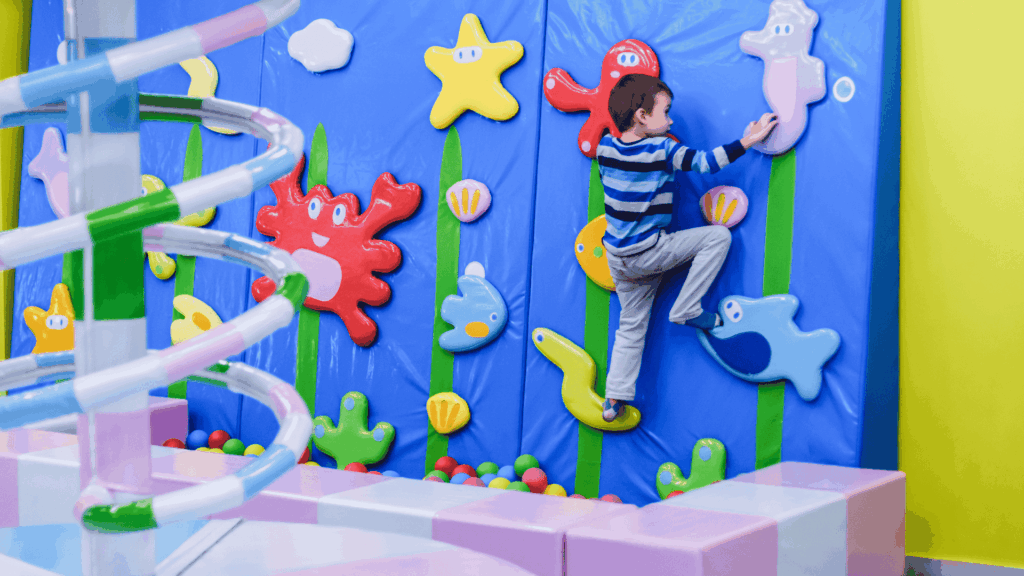When it comes to physical activities that build strength, coordination, and confidence, few things match the power of climbing. But as a parent, you might wonder: what is the best age to introduce your child to a climbing wall? The good news is that modern kids climbing wall setups, especially at places like The Arena, are specifically designed to accommodate different age groups, ensuring safe, age-appropriate fun for all.
In this blog, we’ll explore the ideal age to get your child started, the developmental benefits of climbing, and how indoor facilities provide the perfect environment for young adventurers.
Climbing for Kids: When Is the Right Time to Start?
There’s no one-size-fits-all answer, but most children can be introduced to a beginner climbing wall between 18 months and 3 years old. However, the structure, difficulty, and safety of the wall must be tailored to the child’s developmental stage.
Let’s break it down by age:
1. Toddlers (18 months – 3 years):
At this stage, children are just beginning to explore physical independence. Activities like toddler climbing play using low walls, foam grips, and soft landings help improve gross motor skills, spatial awareness, and confidence.
2. Preschoolers (3 – 5 years):
Children in this range show better balance and coordination. A child-friendly climbing wall with small handholds and gentle inclines encourages active play while helping build climbing fundamentals. At this age, focus should be on fun, not technique.
3. Early Elementary (6 – 9 years):
This is an ideal age to introduce more structured climbing. Children start developing climbing skills for children, such as route planning, grip strength, and endurance. Walls with varied heights and angled holds work well here.
4. Tweens and Up (10+ years):
Kids in this age group can begin exploring more advanced walls, including bouldering walls for kids or top-rope setups under supervision. Technique, strength, and strategy start to become part of the fun.
Why Introduce Your Child to a Climbing Wall?
A kids climbing wall is more than just a recreational activity. It’s a developmental tool. Here’s how climbing supports children’s growth at different levels:
1. Physical Development
Climbing strengthens the core, arms, and legs while also promoting balance and posture. It’s an excellent physical activity for kids that supports muscle tone, flexibility, and agility.
2. Cognitive Growth
Children learn to assess challenges, solve problems, and strategize. Choosing the next handhold or planning a safe descent are examples of early cognitive planning.
3. Confidence & Independence
Conquering even a low indoor climbing wall can be a huge confidence boost. Every successful climb reinforces self-trust and independence valuable lessons for any child.
4. Sensory Integration
Climbing engages multiple senses at once. Touch, sight, and spatial perception helping children integrate and respond to sensory information more effectively.
Safety First: How Climbing Walls Are Designed for Kids
Safety is understandably a top concern for parents. At The Arena, our indoor climbing wall for kids is designed with this in mind:
- Foam-Pit or Padded Landings: Gentle falls and safe exploration are part of the experience.
- Grip-Size Handholds: Small, soft grips suited to little hands ensure proper engagement and grip development.
- Low Heights for Beginners: Our beginner climbing wall section keeps things close to the ground while still offering challenge and fun.
- Supervised Play: Staff ensure your child climbs within their limits, and parents can stay nearby for encouragement.
- Age-Zone Designation: Walls are designed by age range, preventing overcrowding and ensuring appropriate skill-level engagement.
Is Your Child Ready for Climbing?
Every child is unique. Consider the following signs to determine if your little one is ready to take on the climbing wall:
- Shows interest in climbing at home (couches, stairs, etc.)
- Enjoys physical challenges and trying new things
- Has enough balance and coordination to walk and run confidently
- Can follow simple instructions and play cooperatively with others
Still not sure? Book a trial session at The Arena’s indoor climbing space and observe your child in action.
Tips for Introducing Your Child to Climbing
If it’s your child’s first time on a climbing wall, here are some beginner-friendly tips:
- Start Slow – Let them explore the wall at their own pace, even if they don’t climb all the way.
- Cheer Often – Celebrate every attempt, not just the successful climbs.
- Avoid Pressure – Keep it light and fun, especially for toddlers.
- Use Age-Specific Areas – Our dedicated zones ensure they’re climbing with similar-aged peers.
- Stay Nearby – Your presence gives them comfort and courage.
How The Arena in Effingham Makes It Easy
Whether you’re introducing your toddler to early childhood physical development activities or looking for a challenging wall for your 9-year-old, The Arena’s facility has it all.
- Indoor, climate-controlled environment
- Climbing zones tailored by age and skill level
- Trained staff to guide and support
- Combination experiences with trampolines, foam pits, and other soft play adventures
- Clean, well-maintained gear and surfaces
It’s not just a climbing wall it’s a full-family adventure space.
Final Thoughts: Climbing Starts Early and Safely
You don’t need to wait until your child is 10 to introduce them to climbing. With the right environment, supervision, and wall design, even toddlers can enjoy the physical, mental, and emotional benefits of climbing.
So next time you search for a kids climbing wall or wonder about the best age for climbing wall introduction think local, think fun, and think The Arena.
Ready to Let Your Kids Reach New Heights?
Book your visit to The Arena in Effingham today and let your little ones explore the thrill of climbing safely, confidently, and joyfully. We’re here to support every step (and grip) of the way.

